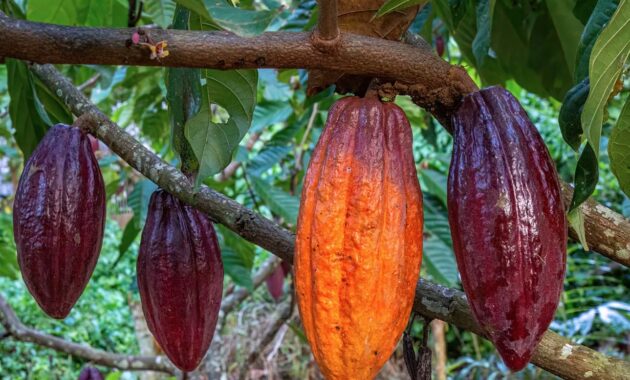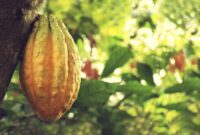
Let me tell you about the incredible Theobroma plant, also known as the cacao tree. If you’re like me and have a passion for chocolate, then the Theobroma cacao is a name that probably makes your heart race. My journey with this plant began when I visited a cacao farm in Ecuador, and honestly, it was a game-changer. Standing among rows of lush cacao trees with ripe pods dangling from their branches felt like stepping into a chocolate lover’s paradise.
What is the Theobroma Plant?
Theobroma cacao is the scientific name for the cacao tree, and it literally means “food of the gods.” This name perfectly encapsulates how special this plant is, not just for its fruit, but for the rich history and culture surrounding chocolate. The plant is native to the tropical regions of Central and South America, thriving in warm, humid conditions.
Key Characteristics of the Theobroma Plant:
- Scientific Name: Theobroma cacao
- Common Names: Cacao tree, cacao
- Family: Malvaceae
- Height: Typically grows to about 4 to 6 meters (13 to 20 feet) in cultivation
- Leaves: Dark green, glossy, and oval-shaped
- Flowers: Small, delicate white to pink flowers that bloom directly from the trunk and branches
- Fruit: The cacao pods, which are typically yellow or orange when ripe, contain the precious cacao beans that are processed into chocolate.
The Lifecycle of the Theobroma Plant
The lifecycle of the Theobroma plant is fascinating, and it’s essential to understand each stage to appreciate the journey from tree to chocolate bar:
- Flowering: The tree starts to produce flowers when it’s about 3 to 5 years old. It’s amazing to see how these tiny blossoms emerge directly from the trunk, and they’re usually pollinated by small insects, especially midges.
- Pod Development: After successful pollination, the flowers develop into cacao pods. These pods take about 5 to 6 months to mature. Each pod can hold around 20 to 50 cacao beans, surrounded by a sweet, white pulp. I remember my first time opening a pod—it was like unearthing a treasure chest filled with gleaming seeds!
- Harvesting: When the pods change color, it’s time to harvest. This is typically done by hand, using a machete or knife. Harvesting cacao is labor-intensive, but it’s also a joyful experience. I can still recall the thrill of cutting the pods and feeling like a real chocolatier!
- Fermentation: After harvesting, the beans are fermented for about 5 to 7 days. This crucial step enhances the flavor, and the aroma that fills the air during fermentation is intoxicating. I once tried skipping fermentation, thinking it wouldn’t make a difference—what a mistake! The resulting chocolate was nowhere near as rich and complex.
- Drying: The beans are then dried under the sun for about 1 to 2 weeks. This process helps to reduce moisture and prepare the beans for roasting. On my first attempt, I neglected to monitor the drying process closely, and some beans ended up molding. Lesson learned!
- Roasting: The dried beans are roasted, which brings out the delightful chocolate flavor we all know and love. This step is essential, and the smell of roasting cacao is simply divine. It’s like a warm hug for the senses!
Growing Your Own Theobroma Plant
If you’re interested in growing your own cacao tree, here are some essential tips that I’ve gathered from my experience:
- Climate Conditions: Theobroma plants thrive in tropical climates with temperatures ranging from 20°C to 32°C (68°F to 90°F). They love humidity and require plenty of moisture. I once tried growing them in a temperate region, and needless to say, they didn’t survive the winter chill.
- Soil Requirements: Cacao trees prefer rich, well-draining soil with a pH of around 6 to 7. Mixing in organic matter and compost can create an ideal environment. I learned that good soil is the foundation of healthy plants!
- Light Needs: Cacao prefers dappled sunlight or partial shade, as it naturally grows under the canopy of taller trees. I made the mistake of placing mine in full sun initially, and the leaves quickly burned. Trust me, shade is their best friend!
- Watering: Consistent watering is crucial. Cacao trees like moist soil but not soggy conditions. I learned the hard way that letting them dry out too much can stress the plant. Now, I stick to a regular watering schedule, and it has made a world of difference!
Caring for Your Theobroma Plant
Once you have your cacao plant, taking care of it is vital to ensure a bountiful harvest:
- Fertilizing: Cacao trees are heavy feeders. Using a balanced fertilizer every 6-8 weeks during the growing season will help promote healthy growth. I’ve had great success with organic fertilizers—my plants are thriving!
- Pruning: Regular pruning is essential to maintain a good shape and encourage airflow. I always find myself pruning during the dry season, which helps my plants flourish when the rains arrive.
- Pest Control: Watch out for common pests like the cacao pod borer and mealybugs. I’ve found that early detection is crucial. Neem oil works wonders for managing pests without harming the environment.
Culinary Uses of Theobroma Cacao
The cacao beans produced by the Theobroma plant are incredibly versatile. Here are some delicious uses I’ve discovered:
- Chocolate Production: The most famous use of cacao is, of course, in chocolate. From dark to milk and even white chocolate, it all starts with those little cacao beans. I love making my own chocolate bars at home—experimenting with flavors like sea salt and chili!
- Baking: Cacao powder is a staple in many baking recipes. Whether it’s brownies, cakes, or cookies, cacao adds a rich flavor that is hard to resist. I keep a jar of high-quality cacao powder in my pantry at all times.
- Beverages: Hot cacao drinks or smoothies with cacao powder are delicious and nutritious. I often make a morning smoothie with cacao, banana, and almond milk for a chocolatey boost. It’s the perfect way to start the day!

Health Benefits of Theobroma Cacao
Beyond its delightful taste, cacao also boasts numerous health benefits:
- Rich in Antioxidants: Cacao is loaded with antioxidants, particularly flavonoids, which help combat oxidative stress. I like to remind my friends that indulging in dark chocolate can be good for you!
- Mood Enhancement: Cacao can improve mood and promote feelings of happiness. Whenever I’m feeling down, a piece of dark chocolate is my go-to pick-me-up. It’s like a little moment of joy in my day!
- Heart Health: Studies suggest that cacao may improve heart health by lowering blood pressure and enhancing circulation. Who knew that chocolate could be so heart-healthy?
Common Challenges in Growing Theobroma Cacao
While growing the Theobroma plant is rewarding, there are challenges to be aware of:
- Pest and Disease Susceptibility: Cacao trees can be vulnerable to various pests and diseases. Keeping a vigilant eye on your plants and acting quickly at the first sign of trouble is essential. I’ve learned that regular inspections save a lot of heartache later!
- Slow Growth Rate: Patience is key. It can take several years before you see a significant harvest, and sometimes, it feels like the plants are just teasing you! However, the wait is worth it when you finally taste your homegrown cacao.
- Temperature Sensitivity: Theobroma cacao is sensitive to cold temperatures. If you live in a cooler climate, consider planting your cacao in a greenhouse or bringing the plants indoors during winter. I’ve found that providing protection during cold snaps helps them thrive.
Final Thoughts
The Theobroma plant is a remarkable species that not only provides us with the delicious chocolate we adore but also holds a special place in various cultures around the world. Whether you’re contemplating growing your own cacao tree or simply enjoying the fruits of others’ labor, understanding the journey of cacao enhances our appreciation for this extraordinary plant.
So, the next time you take a bite of chocolate, remember the beautiful Theobroma plant that made it all possible. It’s a sweet reminder of nature’s generosity and the joy it brings to our lives.
Feel free to let me know if you need more content or have any other topics in mind!



